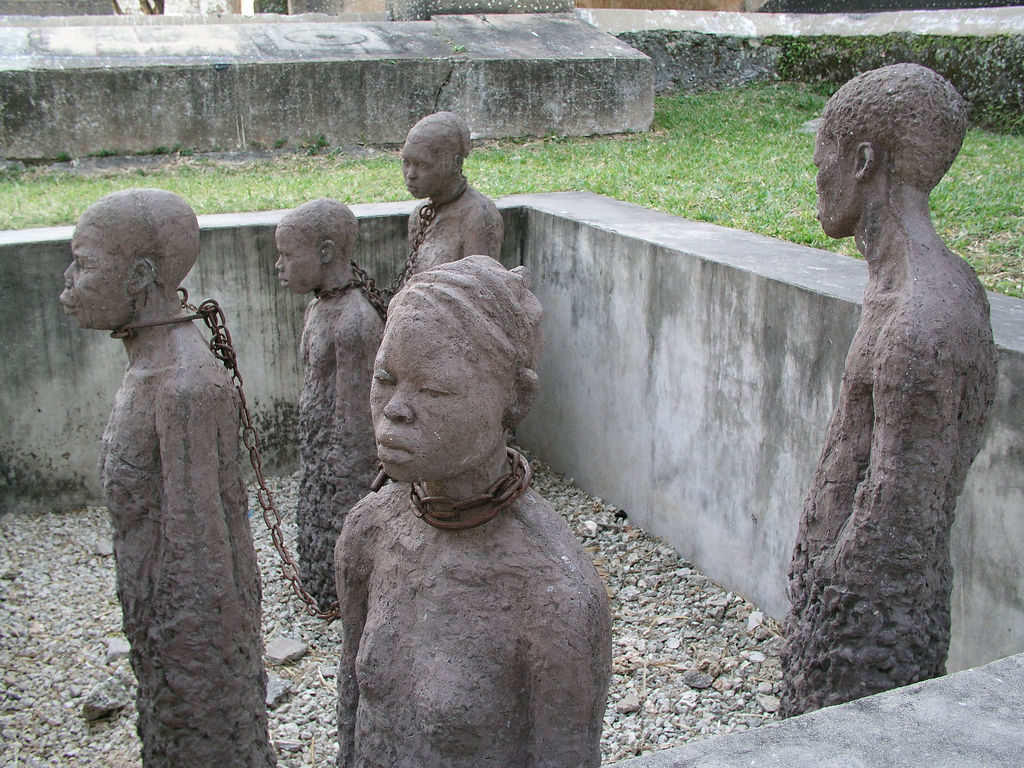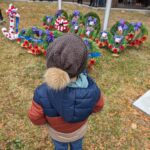By Jonathon Van Maren
The overt religiosity here in Tanzania sometimes crosses the line into the absurd. I’m not just talking about many of the names, which take the form of prayers: Praygod, Godlisten, Godbless, Amina (Amen)—but the names of some of the local establishments. In the village of Usa, for example, I spotted “The Precious Blood of Jesus Christ Beauty Parlor.” A number of women were giggling to each other as they had their hair done on the wooden boardwalk, and seated facing them and waiting were their significant others, pictures of abject misery. Some things do transcend culture.
****
On Thursday, we left Arusha to do a safari in the Ngorogoro Crater and the Serengeti National Park. We drove through dozens of small villages, and the grasslands in between were populated with skeletal herds of goats and cattle tended by Masaai tribespeople, some of them children, wearing bright, vivid robes of red, purple, blue and yellow. On one dusty stretch I saw a Masaai following a single meandering cow, and as I was feeling sorry for him, we drove by two Masaai cowherds attending to a single cow. I assumed that even the agrarian workers of the Masaai tribes have begun to form unions.
****
If there is one feature of the endless grasslands between Arusha and the national parks that stands out, it is the dust. It is fine, gritty stuff and gets into everything—eventually you give up blowing your nose and just wait until the next stop. Because the vehicles have no air-conditioning, the drivers also insist on proceeding with the windows rolled down, which ensures that those in the back seats are the constant recipients of African topsoil. I felt quite sorry for the Maasai villages of grass and mud huts we saw along the way, as I’m sure the nonstop caravan of safari vehicles pounding up the road don’t do much for their quality of life, either.
****
The safari drivers—ours was a young Muslim man named Karim—really know what they’re doing. In order to get the most out of our limited-time park passes, we had to be in and out in just a couple of days. So Karim careened the jeep up rocky roads so steep it ground and groaned in protest, taking hairpin turns up mountain roads at nearly sixty kilometres per hour. This could be quite a risky business, because there were plenty of jeeps coming the opposite way, attempting to get out of the parks by their deadline. It was not unusual for the side mirrors to kiss each other as we sped past each other, and after several hours of this I asked Karim, “Is there a lot of accidents up here?” “It happens,” he replied nonchalantly.
****
Serengeti National Park is perhaps the one traveling experience I have had that met and surpassed the picture I had in my head. I grew up watching National Geographic documentaries such as Lions and Hyenas: Eternal Enemies and countless depictions of the Great Migration, and so I was thrilled to see the real thing. Endless herds of wildebeest, mixed with zebras and hartebeests and gazelles move slowly but inexorably forward, parades of giraffes move sedately onward, towering above it all: It seems as if all of nature is on the move. Nothing can quite compare to watching it unfold.
****
When you first arrive on the Serengeti and move past the herds of herbivores in search of other creatures, everything seems calm and quiet. After a while, you realize that the reason for this is that everything on the grasslands is poised for strike and coiled for takeoff. We watched breathlessly from our jeep as a cheetah crouched behind a termite hill, watching a handful of gazelles a couple hundred metres away. In the opposite direction, a zebra serving as the sentinel for a mixed herd of wildebeest and zebras stood frozen, watching the cheetah and prepared to notify the herd and bolt at a moment’s notice. The zebra stood there for over a half hour, barely twitching, watching the cheetah’s back, while the lean cat waited for the gazelles to come closer. At all times, the grasslands are ready to explode into a life-and-death drama that is magnificent to witness.
****
Traditionally, I don’t like camping. Just to remind me why, a wind-and-dust storm kicked up the first night we camped and blew our tent down over our heads. For those assuming it was my lack of camping skills, Karim was the one who set up our tent while we were out. Walking in the dark, it was important not to trip over a giant pile of Cape buffalo skulls left there by lions to remind us that they were up and hunting. I slept just fine, but apparently a hyena chuckling about something near the tents kept Karim up, and the racoons of the Serengeti, mongooses, ascended from their holes near the bathrooms and robbed everyone blind. I had never seen a mongoose before, so I thought it was really cool. Those who viewed them as thieving raccoons did not. Equally disturbing to some (like Charmaine) were the dozens of little bats who greeted us when we exited our tents in the morning, diving and dipping like barn swallows.
****
The night sky is impossible to describe—first you see thousands of stars, and then so many that the sky tinges white and the galaxies of the Milky Way appear. It was as if every bit of road dust kicked up by the herds and the jeeps and the humans had ascended into space and been touched by angels. It was a Divine canopy, stretching from horizon to horizon. It seemed that every time an atheist demanded evidence of God’s existence, He had placed another star in view as proof.
****
I have never seen such a swift and beautiful sunrise in my life. At 6:00 AM, we drove out onto the plains and parked as the acacia trees on the savanna horizon began to tinge a brilliant yellow. Then, a flaming orb of burnt gold appeared, gliding into view in less than ten minutes, bathing everything in yellow light. It reminded me of the Emily Dickinson lines: “I’ll tell you how the sun rose—a ribbon at a time.”
****
During our first night camping on the edge of the Crater, I headed to the bathroom at around 11 PM. I nearly bumped right into an enormous Cape buffalo, who had climbed up to the campsite and was munching in the garden alongside the path. We both froze and stared, and one of us had a wicked rack of sharp black horns. It wasn’t me, so I promptly fled in the opposite direction. After a few minutes, the buffalo crashed back into the brush. The next morning, Karim thought it was very funny. Then he stopped laughing. “Of course, they are very dangerous, you know.”
****
On our third day, out in the Ngorogoro Crater, we finally got to see one of Africa’s rarest animals: the black rhino. Karim had warned us that we might not get to see one, and so we didn’t get our hopes up. We’d seen leopards leaping into trees, a lion savaging a buffalo carcass while vultures and jackals waited for their turn, hippos sprawled near a pool like obese sunbathers, and nearly sixty other species by my count. Then, Karim’s two-way radio erupted—two black rhinos had been spotted making for a water hole. Karim was excited. “This is very special, very rare,” he told us as he jammed the jeep into gear and took off. It was almost funny—all across the Crater, you could see plumes of dust being kicked high into the air as jeeps spun away from whatever they were watching to join the paparazzi descending onto the two rhinos. They were strolling sedately along, like an aging celebrity couple that only makes the occasional appearance to ensure that everyone still loves them and that they are still a big deal.
****
In the airport at Arusha waiting to fly to Zanzibar, we found ourselves in line behind a Canadian—and a RCMP officer, no less. He worked in nearly twenty countries on international cases, and it turned out that he was one of the Mounties assigned to Amanda Lindhout’s case. Amanda Lindhout, of course, was the Canadian journalist kidnapped and held for seventeen months by Somali militants. Charmaine is a huge fan of her book A House in the Sky, and we had gone to hear Lindhout speak at the Roy Thomson Hall in Toronto earlier this year. Lindhout had told the audience that one of her kidnappers had just been arrested at the Ottawa Airport after law enforcement officials had succeeded in luring him to Canada with promises of—and this isn’t a joke—a book deal. The officer we were chatting with, it turned out, had been one of the cops involved in the takedown. Charmaine was pleased to have met him, to say the least.
****
Zanzibar is a gorgeous island surrounded by turquoise blue waters that was first a sultanate, later a British protectorate, and then was briefly its own country before it merged with Tanganyika in 1964 after a quick, efficient revolution. Stone Town, a UNESCO World Heritage Site, is a small island city full of decrepit, narrow, and twisting alleyways filled with the smell of Oriental spices and the shouting of shop owners. It is largely Muslim—everywhere we looked, we saw women in full, black burqas, which looked absolutely stifling in the suffocating heat. Looking out at Stone Town from above, when we had dinner on the rooftop of the hotel Swahili House, the city looked like a rippling sea of rusting corrugated iron roofs. Throughout the day, the Islamic call to prayer sounded through minarets across the city.
The history I was most interested in here was that of the slave markets, as Zanzibar was once a hub of the East African slave trade. At the Anglican cathedral of the Church of Christ, city officials have set up a new exhibit—Charmaine says it wasn’t here in previous years—where the old slave market used to be. The exhibit was brilliant and chilling, documenting the slave trade from 1800 to 1909. Beneath the old Mission, the slave dungeons feature rusty chains. The air is so thick and stifling it is hard to imagine the low-ceilinged crawl space packed with miserable humanity.
The exhibit told horrifying stories—Arab dhows loaded with slaves pulling up to the Old Fort, but pausing to toss the sick and feeble captives overboard to avoid paying the head tax for damaged merchandise. Later, eating lunch on the pier, I saw Arab dhows sailing past and couldn’t help but imagine the bloated bodies of murdered men and women pulled from burning villages washing up on the shores, abducted and then brutally abandoned. The sultans in Zanzibar—some of their palaces are still here—kept huge harems of slave women for concubines, guarded by eunuchs. The eunuchs were made up of the few male slaves who survived castration as boys in order to serve as guards for the sex slaves of the elites. Even when abolition was finally accomplished here, many of the women were still trapped—the manumission laws did not apply to concubines, who were still considered to be legally “wives.”
****
The same site testifies to what is perhaps the noblest endeavor of the British Royal Navy after William Wilberforce—who was celebrated in one exhibit—successfully banned the slave trade in 1807, and subsequently lived to see slavery banned throughout the British Empire in 1833. Between 1860 and 1890, British warships battled and boarded over 1,000 Arab dhows, often engaging in savage fights to the death with the slave traders. The Christ Church Cathedral, which was established by abolitionist clergymen, did much to battle the slave trade as well. It was actually here that David Livingstone lay in state after his death in 1873—his companions, former slaves freed by the missionary, buried his heart under a tree in Zambia before carrying his body over 1,000 miles to deliver him to those who would carry him to his final resting place in Westminster Abbey. At the front of the cathedral stands a crucifix carved from the wood of the tree that stands sentinel over Livingstone’s heart.
Underneath three magnificent stained glass windows inside the cathedral, a brass plaque is fastened. It reads: “To the Glory of GOD, and in memory of Livingstone and other explorers, men good and brave, who to advance knowledge, set free the slave, and hasten Christ’s Kingdom in Africa, loved not their lives, even into death: this Window is dedicated by their friends.”
****
We’ve been privileged to see more African wildlife than I could have imagined already—on Zanzibar Island alone, we watched the waves of the Indian Ocean crested with silver dolphins, and the mangrove trees of the Jozani Rainforest echo with the chattering of Red Colobus monkeys. But what awaited us on the Prison Island Tortoise Sanctuary, a twenty-minute boat ride off the coast of Stone Town, beat it all.
Prison Island was once a holding pen for rebellious slaves put there by Arab slave traders who didn’t want to risk escape attempts in Zanzibar. Later, it was intended to be the home of a prison for dangerous criminals, but ended up being a quarantine site for severely ill sea passengers. The would-be prison is now a restaurant.
Next to the prison is the Tortoise Sanctuary, home to the oldest living animals on earth. One tortoise, a solemn, ponderous fellow with a deformed shell where it had broken over the ages, is 192 years old. I scratched his neck and thought of everything he had outlived—hatched in 1824, he predated the American Civil War, the final triumph of William Wilberforce, the Russian Revolution, and both world wars. The tortoise relaxing under a tree next to him was young by comparison—he was only 158 years old.
To be continued….








